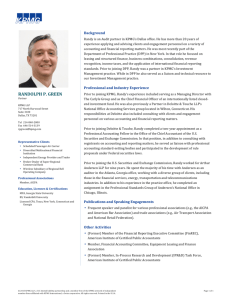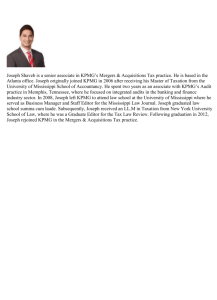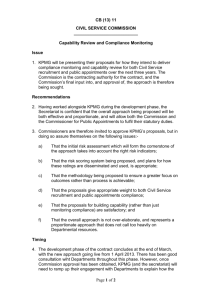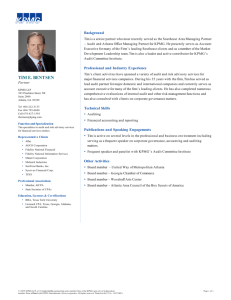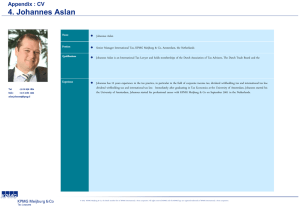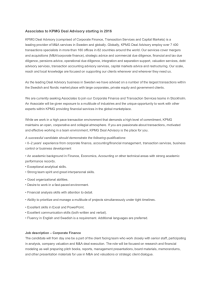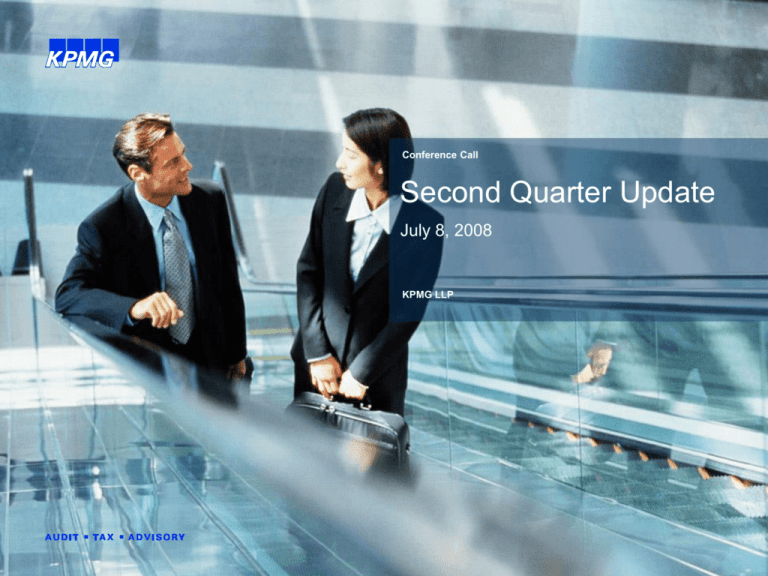
Conference Call
Second Quarter Update
July 8, 2008
KPMG LLP
© 2008 KPMG LLP, a Canadian limited liability partnership and a member firm of the KPMG network of independent member firms affiliated with KPMG International,
a Swiss cooperative. All rights reserved.
1
Agenda
• Canadian Internal Control Over Financial Reporting
– Murray Suey
• IFRS Developments
– John Gordon
• Tax Issues for IFRS
– Jodi Roworth
• Budget Update
– Chris Post
• International Tax Developments
– Jim Samuel
• Merger & Acquisition Environment
– Rhys Renouf
• SEC Update
–Wayne Chodzicki
© 2008 KPMG LLP, a Canadian limited liability partnership and a member firm of the KPMG network of independent member firms affiliated with KPMG International,
a Swiss cooperative. All rights reserved.
2
Canadian Internal Control Over Financial Reporting
Murray Suey
Partner, Audit
403.691.8474
msuey@kpmg.ca
© 2008 KPMG LLP, a Canadian limited liability partnership and a member firm of the KPMG network of independent member firms affiliated with KPMG International,
a Swiss cooperative. All rights reserved.
3
Canadian Internal Control Over
Financial Reporting
Currently
• certified as to design of internal controls only
Proposal
• certify as to effectiveness of internal controls
© 2008 KPMG LLP, a Canadian limited liability partnership and a member firm of the KPMG network of independent member firms affiliated with KPMG International,
a Swiss cooperative. All rights reserved.
4
Highlights of Proposed NI 52-109
Certify on effectiveness of internal control over financial reporting
(ICFR) for periods ending after December 15, 2008
• Significant documentation requirements
• Much closer to current SEC guidance
−
−
−
−
top-down, risk-based approach
definition of material weakness
scope exemptions (i.e. business acquisition – 365 days)
requires use of a control framework, (i.e., COSO)
• Recommends disclosure of significant weaknesses in disclosure controls
and procedures (DC&P)
− a material weakness in ICFR “often” means ineffective DC&P
• Venture issuers are exempt from DC&P and ICFR certifications
© 2008 KPMG LLP, a Canadian limited liability partnership and a member firm of the KPMG network of independent member firms affiliated with KPMG International,
a Swiss cooperative. All rights reserved.
5
Summary of Responsibilities under
Proposed NI 52-109
CEO and CFO
• Certify design and effectiveness of DC&P and ICFR and report
conclusions in MD&A
• Maintain documentary evidence to support the certification
Audit Committee and Board of Directors
• BOD to approve the issuer’s annual MD&A, including disclosures
concerning DC&P and ICFR
• Understand the basis for conclusions regarding material
weaknesses
© 2008 KPMG LLP, a Canadian limited liability partnership and a member firm of the KPMG network of independent member firms affiliated with KPMG International,
a Swiss cooperative. All rights reserved.
6
Summary of Responsibilities under
Proposed NI 52-109 cont'd
KPMG
• Under our professional standards, we will read MD&A and assess
any inconsistencies with our knowledge and any apparent material
misstatement of fact or misrepresentation. We will also
communicate any failure to meet the requirements of securities
legislation of which we are aware
− We are not required to search out securities violations and are not
required to read management’s documentation and evaluation of
DC&P and ICFR
© 2008 KPMG LLP, a Canadian limited liability partnership and a member firm of the KPMG network of independent member firms affiliated with KPMG International,
a Swiss cooperative. All rights reserved.
7
How KPMG can Help
To assist management and/or the audit committee with
respect to their responsibilities, KPMG can perform a number
of services. We can:
• Perform a more thorough readiness assessment to assist
management and the Audit Committee in understanding the degree
to which management is progressing in preparing for the ultimate
certification requirements of proposed NI 52-109
• Provide observations and recommendations based on a detailed
review of management’s documentation as it is developed to meet
the provisions of NI 52-109
• Assist in documenting controls including entity-level controls,
period-end financial reporting workflows and controls, process level
workflows and controls, information technology general controls
and IT application controls
© 2008 KPMG LLP, a Canadian limited liability partnership and a member firm of the KPMG network of independent member firms affiliated with KPMG International,
a Swiss cooperative. All rights reserved.
8
How KPMG can Help cont'd
• Carry out procedures of an audit nature, including testing, upon
which we have agreed in advance, and report the findings
• Provide an audit of internal control over financial reporting that is
integrated with an audit of financial statements. We may perform
audit engagements regarding aspects of an entity's internal control
over financial reporting including a particular process, subsidiary or
the entity as a whole
© 2008 KPMG LLP, a Canadian limited liability partnership and a member firm of the KPMG network of independent member firms affiliated with KPMG International,
a Swiss cooperative. All rights reserved.
9
IFRS Developments
John Gordon
Partner
403.691.8118
johngordon@kpmg.ca
© 2008 KPMG LLP, a Canadian limited liability partnership and a member firm of the KPMG network of independent member firms affiliated with KPMG International,
a Swiss cooperative. All rights reserved.
10
Update
AcSB’s progress
review completed!
Jan 1/07
Calendar
year
periods
Jan 1/08
AcSB/IASB IFRS 1
submission
Jan 1/09
CSA (revised) tentative
conclusions
Disclosure
convergence plan per Q
Changeover
date
Jan 1/10
IASB to finalize
O&G IFRS 1
exemption?
IFRS
Opening
Balance
Sheet
Developments:
IASB: IFRS 1 proposed exemption for oil and gas industry (Q3 2009?)
CSA: MD&A disclosures
CSA: Update on “Tentative Conclusions”
Jan 1/11
IFRS
Comparative
figures
IFRS
go-live
Last reporting
under
Canadian GAAP
© 2008 KPMG LLP, a Canadian limited liability partnership and a member firm of the KPMG network of independent member firms affiliated with KPMG International,
a Swiss cooperative. All rights reserved.
11
IFRS 1 – First-time Adoption of IFRS
“Break” for O&G Industry
• IASB meeting March 2008: CAPP's submission regarding
proposed IFRS 1 amendments:
− “IFRS 1 be amended to permit an allocation in the opening IFRS balance
sheet of the full cost pool to individual assets, with each asset being
subject to an impairment test at that date.”
− AcSB instructed to work with IASB staff to create proposal and develop
a more comprehensive description of issue
© 2008 KPMG LLP, a Canadian limited liability partnership and a member firm of the KPMG network of independent member firms affiliated with KPMG International,
a Swiss cooperative. All rights reserved.
12
IFRS 1 – First-time Adoption of IFRS
“Break” for O&G Industry cont'd
• IASB meeting May 2008: AcSB's presented IFRS 1 proposal:
− IASB approved AcSB's suggested disclosure requirements re IFRS 1
proposed exemption
− Suggested disclosure requirement was presented and stated:
"Paragraph XX provides an exemption for oil and gas assets. If an entity
uses that exemption, it shall disclose that fact and the basis on which
carrying amounts under previous GAAP were allocated."
• AcSB will draft ED: will receive a 120 day comment period
• Final IFRS 1 amendment not expected before Q3 2009
© 2008 KPMG LLP, a Canadian limited liability partnership and a member firm of the KPMG network of independent member firms affiliated with KPMG International,
a Swiss cooperative. All rights reserved.
13
CSA Notice 52-320
IFRS Disclosure
• May 9, 2008 CSA Notice 52-320, “Disclosure of Expected Changes
in Accounting Policies relating to Changeover to IFRS”
• Changeover IFRS = changes due to new accounting standards
• CSA: within scope of current MD&A form requirements that apply
to annual and interim MD&A filed in compliance with National
Instrument 51-102, Continuous Disclosure Obligations, as well
as MD&A included in a prospectus
• Requirements in other securities legislation might also require
disclosure of specific information about broader implications of
changeover to IFRS
© 2008 KPMG LLP, a Canadian limited liability partnership and a member firm of the KPMG network of independent member firms affiliated with KPMG International,
a Swiss cooperative. All rights reserved.
14
CSA Notice 52-320
IFRS Disclosure
• Disclosure “relating to each financial reporting period in the
three years before the first year (2011) financial statements
prepared in accordance with IFRS”
• Disclosure begins as early as Q2 2008 MD&A (for
companies that have developed IFRS changeover plans)
and no later than the annual 2008 MD&A
© 2008 KPMG LLP, a Canadian limited liability partnership and a member firm of the KPMG network of independent member firms affiliated with KPMG International,
a Swiss cooperative. All rights reserved.
15
CSA Notice 52-320
IFRS Disclosure
• CSA staff desire an incremental approach to disclosure
• Level of detail and amount of quantified information increases
as move closer to 2011
• Key elements of a changeover plan may address impact on:
− accounting policies, including choices among policies permitted under
IFRS, and implementation decisions such as whether certain changes
will be applied on a retrospective or a prospective basis
− information technology and data systems
− internal controls over financial reporting
− disclosure controls and procedures, including investor relations
and external communications plans
− sufficiency of financial reporting expertise, including training
requirements
− business activities that may be influenced by GAAP measures such
as foreign currency, hedging, debt covenants, capital requirements
and compensation arrangements.
© 2008 KPMG LLP, a Canadian limited liability partnership and a member firm of the KPMG network of independent member firms affiliated with KPMG International,
a Swiss cooperative. All rights reserved.
16
CSA Notice 52-320
IFRS Disclosure Communication 2008
2008 annual and interim MD&A disclosure
(3 years to changeover)
• Interim MD&A
− Developed IFRS changeover plan?
Discuss key elements and timing
− Well advanced in IFRS project?
Discuss impact of IFRS changeover on financial reporting
• Annual MD&A
− No later than three years before changeover date
Discuss status key elements and timing plan
− Well advanced in IFRS project?
Discuss impact of IFRS changeover on financial reporting
© 2008 KPMG LLP, a Canadian limited liability partnership and a member firm of the KPMG network of independent member firms affiliated with KPMG International,
a Swiss cooperative. All rights reserved.
17
CSA Notice 52-320
IFRS Disclosure Communication 2009
2009 annual and interim MD&A disclosure
(2 years to changeover)
• Interim MD&A
− Provide update progress on IFRS plan and changes
• Annual MD&A
− Discuss preparations for changeover to IFRS, building on aspects
discussed in 2008 and interim 2009 MD&A
− To allow investors to understand the key elements of the financial
statements that will be affected, narrative description of major identified
differences between current accounting policies and those required /
expect to apply in preparing IFRS financial statements, including
assumptions about future changes to IFRS
© 2008 KPMG LLP, a Canadian limited liability partnership and a member firm of the KPMG network of independent member firms affiliated with KPMG International,
a Swiss cooperative. All rights reserved.
18
CSA Notice 52-320
IFRS Disclosure Communication 2010
2010 annual and interim MD&A disclosure
(1 year to changeover)
• Interim and Annual MD&A
− Provide updated discussion of preparations, building on aspects
discussed in 2008, 2009, and interim 2010 MD&A
− Discuss in more detail key decisions and changes (to be) made
relating to changeover, including decisions about accounting policy
choices under IFRS 1 and other relevant individual IFRS standards
− When preparing interim and annual MD&A, if have available quantified
information on impact of IFRS on key line items in financial statements,
included in MD&A
© 2008 KPMG LLP, a Canadian limited liability partnership and a member firm of the KPMG network of independent member firms affiliated with KPMG International,
a Swiss cooperative. All rights reserved.
19
CSA Notice 52-321
Update Staff Concept Paper re IFRS
© 2008 KPMG LLP, a Canadian limited liability partnership and a member firm of the KPMG network of independent member firms affiliated with KPMG International,
a Swiss cooperative. All rights reserved.
20
CSA Notice 52-321
Update Staff Concept Paper
• June 27, 2008 CSA Notice 52-321, “Early Adoption IFRS, Use of
US GAAP and Reference to IASB-IFRS”
• Notice 52-321 updated issues addressed in CSA Concept Paper
52-402 on "Possible changes to securities rules related to IFRS (the
concept paper or tentative conclusions)”
• 42 comment letters: CSA Staff further developed their views
• Staff now propose that for Canadian domestic issuers, who are also
SEC registrants, the existing option in NI 52-107 would be retained,
and US GAAP could be used
− limited to Canadian SEC registrant companies
© 2008 KPMG LLP, a Canadian limited liability partnership and a member firm of the KPMG network of independent member firms affiliated with KPMG International,
a Swiss cooperative. All rights reserved.
21
CSA Notice 52-321
Update Staff Concept Paper
Staff continue to propose that IFRS could be early adopted:
• Exemptive relief on case-by-case basis
• Assess readiness staff, Board, AC, auditor, investors
• Consider implications on obligations under securities legislation
including CEO/CFO certifications, BARs, offering documents,
previously released material forward-looking information
If choose to early adopt and previously filed interim reports
under “old GAAP” in first year proposing to adopt IFRS:
• Revise interim financial statements
• Revise MD&A
• Issue new certificates
© 2008 KPMG LLP, a Canadian limited liability partnership and a member firm of the KPMG network of independent member firms affiliated with KPMG International,
a Swiss cooperative. All rights reserved.
22
IFRS & Tax: Why us Tax Geeks should care?
Jodi L. Roworth
Senior Principal, Tax
403.691.8092
jroworth@kpmg.ca
© 2008 KPMG LLP, a Canadian limited liability partnership and a member firm of the KPMG network of independent member firms affiliated with KPMG International,
a Swiss cooperative. All rights reserved.
23
Why move to International Financial
Reporting Standards (IFRS)?
What are they?
• Single set of globally-accepted, high-quality accounting standards
• Used in 100+ countries, including five G8 countries
Rationale for Canada’s move to IFRS:
• Provide better access to global capital markets
• Move to principles-based standards and away from rule-based U.S.
standards (costly / difficult to apply)
• More cost effective than maintaining Canadian GAAP
U.S GAAP & IFRS – likely more aligned over time
© 2008 KPMG LLP, a Canadian limited liability partnership and a member firm of the KPMG network of independent member firms affiliated with KPMG International,
a Swiss cooperative. All rights reserved.
24
Timeline for Canada’s adoption of
IFRS
Group 2:
IFRS under development
at change-over date
e.g. leases, revenues, employee benefits
Group 5:
Cdn standards – no IFRS equivalent
Expected to be discontinued
e.g. AcG 16 – full cost, rate reg’d accg
2007
2008
Group 1:
Converge prior to
change-over date
e.g. inventories,
business combinations,
income taxes,
earnings per share
2009
2010
2011
Group 3:
Canadian GAAP replaced at
change-over date
e.g. impairment, securitizations,
financial instruments
Group 4:
IFRS with no Canadian GAAP equivalent:
Adopt at change-over date
e.g. provisions, biological assets
© 2008 KPMG LLP, a Canadian limited liability partnership and a member firm of the KPMG network of independent member firms affiliated with KPMG International,
a Swiss cooperative. All rights reserved.
25
IAS 12 – Income Taxes
IAS 12 Income Taxes – October 1996
• Paragraphs 1-91
• All paragraphs have equal authority
Fundamental Principle
It is inherent in the recognition of an asset or liability that the
reporting entity expects to recover or settle the carrying amount of
that asset or liability. If it is probably that recovery or settlement of
that carrying amount will make future tax payments larger (smaller)
than they would be if such recovery or settlement were to have no
tax consequences, this Standard requires an entity to recognize a
deferred tax liability (deferred tax asset), with certain limited
exceptions.
© 2008 KPMG LLP, a Canadian limited liability partnership and a member firm of the KPMG network of independent member firms affiliated with KPMG International,
a Swiss cooperative. All rights reserved.
26
Scope
Income Taxes
=
Current Taxes
+
Deferred Taxes
• The scope of IAS 12 includes:
All domestic and foreign taxes which are based on taxable profits.
Income taxes also include taxes, such as withholding taxes, which are
payable by subsidiary, associate or joint venture entities on distributions to
the parent entity.
• Taxes that are not based on taxable profits are not within the scope
of IAS 12 (i.e., payroll taxes and value added taxes)
• Excludes accounting for government grants or investment tax
credits; however, does account for temporary differences that may
arise from such grants or ITCs
© 2008 KPMG LLP, a Canadian limited liability partnership and a member firm of the KPMG network of independent member firms affiliated with KPMG International,
a Swiss cooperative. All rights reserved.
27
Tax Convergence Project – Group 1
• IASB and FASB – objective to reduce the differences between IAS
12 and FAS109
• Exposure Drafts expected to be published in 2008/final standard
in 2009
• Both based on the balance sheet liability approach whereby
an entity recognizes DITA/DITL for TD and loss carryforwards
• Differences arise because both standards have numerous
exceptions to the basic principle
• Approach to convergence is to eliminate exceptions, not to
reconsider the underlying approach
• Added to the Boards agenda in September 2002 (not a short
project)
• AcSB has indicated that it is their intent to adopt revised IAS 12
IASB/FASB
without modification.
Convergence
© 2008 KPMG LLP, a Canadian limited liability partnership and a member firm of the KPMG network of independent member firms affiliated with KPMG International,
a Swiss cooperative. All rights reserved.
28
Comparison (IAS 12/CICA
3465/FAS109)
•
•
•
•
•
•
•
•
•
•
•
•
Exceptions – Goodwill & Initial Recognition
Investments in Subs/Joint Ventures – Outside Basis
Enacted vs. Substantive enactment
Business Combination – previously unrecognized tax asset
Compound Financial Instruments
Tax Credits & ITC’s – not part of IAS12
Presentation – Current vs. Long-Term
Allocation within consolidated group
Intra-period Allocations – Equity vs. Income
Interim Period Taxes
Disclosure
Uncertain Tax Positions
© 2008 KPMG LLP, a Canadian limited liability partnership and a member firm of the KPMG network of independent member firms affiliated with KPMG International,
a Swiss cooperative. All rights reserved.
29
Other IFRS Differences
• Provisions, Cont liabilities/assets
( IAS
37)
•
•
•
•
•
•
•
•
Property, Plant & Equipment (IAS 16)
Financial Instruments (IAS 39)
Intangible Assets and Goodwill (IAS 38)
Investment Property (IAS 40)
Impairment (IAS 36)
Revenue Recognition (IAS 11 & 18)
Government Grants (IAS 20)
Related Parties (IAS 24)
•
•
•
•
Leases (IAS 17)
Debt vs. Equity Classification (IAS 32)
Derivatives and hedging (IAS 39)
Pensions and post-retirement benefits
(IAS 19)
• Consolidations, equity method and
joint ventures (IAS 27, 28, 31)
• Rate Regulated
• Share based payments (IAS 2)
• Events After the Balance Sheet date
(IAS 10)
• First Time Adoption (IAS 1)
© 2008 KPMG LLP, a Canadian limited liability partnership and a member firm of the KPMG network of independent member firms affiliated with KPMG International,
a Swiss cooperative. All rights reserved.
30
Oil and Gas Industry: Where are we
after May announcement?
Expected 2011 change-over date – to be finalized
in early 2008
•
•
•
•
AcSB not expected to keep AcG-16
AcSB not expected to delay implementation
AcSB not expected to allow exceptions to IFRS
AcSB not expected to modify IFRS 1 transition standard
IFRS Extractive Industries project not complete by 2011
• AcSB not expected to “wait” for project completion as project not
likely to completed before 2012
© 2008 KPMG LLP, a Canadian limited liability partnership and a member firm of the KPMG network of independent member firms affiliated with KPMG International,
a Swiss cooperative. All rights reserved.
31
IFRS Impact on Tax Reporting
and Tax Filings
• Income Tax Act of Canada (“ITA”) – no requirement directing the
use of one particular accounting methodology when preparing tax
filings – therefore IFRS/CDN GAAP both acceptable
• Management will need to assess what, if any, adjustments to
accounting profit are required to arrive at taxable profit per the ITA
• IFRS impact on the balance sheet may also impact a company’s
tax on capital
• CRA has not issued any formal statement or guidance on the
effects of the transition to IFRS
© 2008 KPMG LLP, a Canadian limited liability partnership and a member firm of the KPMG network of independent member firms affiliated with KPMG International,
a Swiss cooperative. All rights reserved.
32
IFRS Impact on Tax Reporting and
Tax Filings
• Understand differences in reported balances under IFRS for both
first-time adoption and on ongoing basis
• Determine proper treatment on the company’s tax returns
• Changing the accounting treatment under IFRS will raise several
questions:
− Is there a financial conformity rule that needs to be followed under the
tax law?
− Can the historical tax method be continued?
− Does the company have the information to compute and schedule new
TD?
© 2008 KPMG LLP, a Canadian limited liability partnership and a member firm of the KPMG network of independent member firms affiliated with KPMG International,
a Swiss cooperative. All rights reserved.
33
Income Tax vs. Royalty
IAS 12
• For the purposes of this standard, income taxes include all
domestic and foreign taxes which are based on taxable profits.
• Taxable profit (tax loss) is the profit(loss) for a period,
determined in accordance with the rules established by the
taxation authorities, upon which income taxes are payable
(recoverable)
© 2008 KPMG LLP, a Canadian limited liability partnership and a member firm of the KPMG network of independent member firms affiliated with KPMG International,
a Swiss cooperative. All rights reserved.
34
Income Tax vs. Royalty
AAcSB – Australian Accounting Standards Board
• Australian Petroleum Resource Rent Tax
Canadian/World-Wide Issues
•
•
•
•
•
Oilsands Royalty
Ontario Mining Tax
Potash Production Tax
Foreign Profit based royalties
Licence agreements
© 2008 KPMG LLP, a Canadian limited liability partnership and a member firm of the KPMG network of independent member firms affiliated with KPMG International,
a Swiss cooperative. All rights reserved.
35
KPMG IFRS Publications
External Canadian IFRS Website
• www.kpmg.ca/ifrs
KPMG’s IFRS publications posted on www.kpmg.ca/ifrs
Publications include
•
•
•
•
IFRS compared to Canadian GAAP: An overview (Fall 2007)
Managing the Transition to IFRS: The Journey to 2011
IFRS: An Overview – An executive summary of the key requirements of IFRS
Illustrative Financial Statements
− First-time adopters
− Different industries
• The Transition to IFRS: Implications for the Audit Committee (06/2007)
© 2008 KPMG LLP, a Canadian limited liability partnership and a member firm of the KPMG network of independent member firms affiliated with KPMG International,
a Swiss cooperative. All rights reserved.
36
The Alberta Budget
Chris Post
Partner
403.691.8434
cpost@kpmg.ca
© 2008 KPMG LLP, a Canadian limited liability partnership and a member firm of the KPMG network of independent member firms affiliated with KPMG International,
a Swiss cooperative. All rights reserved.
37
The Alberta Budget – 2008
SR&ED Tax Incentive Introduced for corporations
•
•
•
•
Refundable Tax Credit
10% of qualified expenditures in Alberta
Expenditures incurred after December 31, 2008
Annual maximums:
− Expenditures in Alberta of $4,000,000
− Refundable tax credit $400,000
• Same rules and benefits apply to CCPC’s, public corporations, nonresident corporations with a branch in Alberta
• Alberta ITC’s will “grind” the federal SR&ED base for federal ITC’s
• No technical details published yet
© 2008 KPMG LLP, a Canadian limited liability partnership and a member firm of the KPMG network of independent member firms affiliated with KPMG International,
a Swiss cooperative. All rights reserved.
38
The Alberta Budget – 2008
IMPACT ON LARGE CORPORATIONS:
Annual SR&ED Expenditures, say
Before
After
$10,000
$10,000
Federal ITC
(2,000)
(1,800)
Alberta ITC
-
(1,000)
(2,900)
(2,900)
580
812
$5,680
$5,112
Tax saving, deduction of SR&ED costs
Tax cost of all SR&ED ITC’s
After-tax cost of SR&ED in Alberta
Improvement
© 2008 KPMG LLP, a Canadian limited liability partnership and a member firm of the KPMG network of independent member firms affiliated with KPMG International,
a Swiss cooperative. All rights reserved.
$568
39
The Alberta Budget – 2008
IMPACT ON CCPC’s:
Annual SR&ED Expenditures, say
Before
After
$10,000
$10,000
Federal ITC
(3,500)
(3,150)
Alberta ITC
-
(1,000)
(1,400)
(1,400)
490
581
$5,590
$5,031
Tax saving, deduction of SR&ED costs
Tax cost of all SR&ED ITC’s
After-tax cost of SR&ED in Alberta
Improvement
© 2008 KPMG LLP, a Canadian limited liability partnership and a member firm of the KPMG network of independent member firms affiliated with KPMG International,
a Swiss cooperative. All rights reserved.
$559
40
The Alberta Budget – 2008
Other Corporate Budget Measures
• Harmonisation with federal measures on:
− Capital cost allowance classes
(if and when the fed’s enact!)
Rental properties with M&P and other business tenants, computer
equipment, etc.
• Establish $100 million Alberta Enterprise Corporation to improve
access to capital for early-stage knowledge-based companies
• No changes to:
− corporate tax rate
− small business tax rate
− small business limits
© 2008 KPMG LLP, a Canadian limited liability partnership and a member firm of the KPMG network of independent member firms affiliated with KPMG International,
a Swiss cooperative. All rights reserved.
41
The Alberta Budget – 2008
Other Personal Budget Measures
• Lower non-eligible dividend threshold from $460,000 (Alberta small
business limit) to $400,000 (federal small business limit)
− eliminate over-integration on dividends paid on $60,000 income
eligible for Alberta small business limit in excess of federal limit
− Technical details not released yet
• Harmonisation with federal measures on:
− Tax-Free Savings Accounts (TFSA’s) - $5,000 annual contribution
starting in 2009
• Health Care insurance premiums eliminated after 2008
• Annual Alberta Caregiver and Disability Tax Credits, and Income
Thresholds, all increased by $5,000 over inflation indexing for 2008
• Alberta Family Employment Tax Credit increases 10%, July 1, 2008
© 2008 KPMG LLP, a Canadian limited liability partnership and a member firm of the KPMG network of independent member firms affiliated with KPMG International,
a Swiss cooperative. All rights reserved.
42
Other Alberta Tax Developments
Previously-scheduled Alberta small business limit changes:
• From $430,000 to $460,000 effective April 1, 2008
• Scheduled to go to $500,000 effective April 1, 2009
Personal tax credit indexing for 2008
• 4.7% increase over 2007 amounts
© 2008 KPMG LLP, a Canadian limited liability partnership and a member firm of the KPMG network of independent member firms affiliated with KPMG International,
a Swiss cooperative. All rights reserved.
43
June Federal Developments
1. Bill C-50 containing most of the tax measures of the 2008
federal budget substantively enacted in June for both
Canadian and US GAAP
2. Deadline for filing election to report for tax purposes in
functional currency deferred to October 31, 2008
•
from June 30
3. Deadline for filing election on application of Foreign
Affiliate amendments deferred by 18 months
•
For a December 31, 2007 year-end – from June 30, 2008 to
December 31, 2009
© 2008 KPMG LLP, a Canadian limited liability partnership and a member firm of the KPMG network of independent member firms affiliated with KPMG International,
a Swiss cooperative. All rights reserved.
44
International Tax
Jim Samuel
Partner, Tax
403.691.8349
jjsamuel@kpmg.ca
© 2008 KPMG LLP, a Canadian limited liability partnership and a member firm of the KPMG network of independent member firms affiliated with KPMG International,
a Swiss cooperative. All rights reserved.
45
International Tax
• International Tax Advisory Panel
• Protocol – U.S. – Canada Tax Treaty
• Foreign Affiliate Elections
© 2008 KPMG LLP, a Canadian limited liability partnership and a member firm of the KPMG network of independent member firms affiliated with KPMG International,
a Swiss cooperative. All rights reserved.
46
Merger & Acquisition Environment
Rhys Renouf
Partner, Advisory Services
403.691.8426
rrenouf@kpmg.ca
© 2008 KPMG LLP, a Canadian limited liability partnership and a member firm of the KPMG network of independent member firms affiliated with KPMG International,
a Swiss cooperative. All rights reserved.
47
E & P and Energy Services
Industry Overview
What a difference a year makes
• Much more optimistic outlook today compared to 2007
− Key factors driving optimism include high commodities prices, emerging
resource plays (Bakken, Montney, Horn River, Utica) and strong cash flows
for producers
− Record cash flows are expected to drive increased capital expenditure
budgets and drilling activity in H2 2008 and into 2009
− High commodity prices have mitigated the impact of Alberta royalty structure
− Current pricing environment should allow companies to strengthen balance
sheets and reduce debt levels
• Energy services companies stand to benefit from higher capex budgets
−
−
−
−
Demand for directional drilling and pressure pumping is especially strong
Migration of rigs from Canada to the U.S. is coming to a halt
Pricing power expected to return for service providers in late 2008 or 2009
Labour continues to be the limiting factor
© 2008 KPMG LLP, a Canadian limited liability partnership and a member firm of the KPMG network of independent member firms affiliated with KPMG International,
a Swiss cooperative. All rights reserved.
48
Public Equity Valuations
Percentage Change Since January 1, 2008
2008 Returns:
Commodity Prices and Equity M arket Indices
100%
80%
60%
WTI Price ($CAD)
AECO-C Price ($CAD)
TSX Energy Services Index
TSX Energy Index
TSX Composite Index
91%
49%
40%
27%
26%
20%
5%
0%
-20%
-40%
Jan-08
Feb-08
M ar-08
Apr-08
M ay-08
Jun-08
• Publicly traded energy
companies have
underperformed relative
to commodity prices
• Significant changes in
the underlying
fundamentals (i.e.
commodity prices) have
not been fully reflected
in valuations
• YTD returns for
producers and service
providers are highly
correlated
Sources: Bloomberg, Google Finance
© 2008 KPMG LLP, a Canadian limited liability partnership and a member firm of the KPMG network of independent member firms affiliated with KPMG International,
a Swiss cooperative. All rights reserved.
49
Mergers & Acquisitions Environment
Producers
• Commodities prices have solved most of the debt issues that were present
in 2007
− Liquidity is creating a positive setting for M & A activity
− Look for larger premiums as valuations increase, especially in emerging resource
play areas
− Strong cash flows are increasing cash reserves or reducing debt, paving the way
for strong asset and corporate M & A activity
Energy Services
• Geographic diversification and operational focus are the driving force
− Large Canadian firms are actively pursuing geographic diversification, particularly
in the U.S. – acquisitions are a vital part of this effort
− Unlike producers, several distressed situations exist on the services side
− Look for more share-for-share exchanges such as Builders/Essential
− Divestitures of non-core divisions in order to maintain operational focus are likely to
continue (i.e. Essential divests its transport division to focus on downhole services)
Sources: Scotia Capital, Tristone Capital
© 2008 KPMG LLP, a Canadian limited liability partnership and a member firm of the KPMG network of independent member firms affiliated with KPMG International,
a Swiss cooperative. All rights reserved.
50
SEC Update
Wayne Chodzicki
Partner
403.691.8004
wchodzicki@kpmg.ca
© 2008 KPMG LLP, a Canadian limited liability partnership and a member firm of the KPMG network of independent member firms affiliated with KPMG International,
a Swiss cooperative. All rights reserved.
51
kpmg.ca
DISCLAIMER
The information contained herein is of a general nature and is not intended to address the circumstances of any particular individual or
entity. Although we endeavor to provide accurate and timely information, there can be no guarantee that such information is accurate as
of the date it is received or that it will continue to be accurate in the future. No one should act on such information without appropriate
professional advice after a thorough examination of the particular situation.
KPMG and the KPMG logo are registered trademarks of KPMG International, a Swiss cooperative.
© 2008 KPMG LLP, a Canadian limited liability partnership and a member firm of the KPMG network of independent member firms
affiliated with
International,
a Swiss
cooperative.
All rights
© 2008KPMG
KPMG LLP,
a Canadian limited
liability partnership
and a member
firm ofreserved.
the KPMG network of independent member firms affiliated with KPMG International,
a Swiss cooperative. All rights reserved.
52


